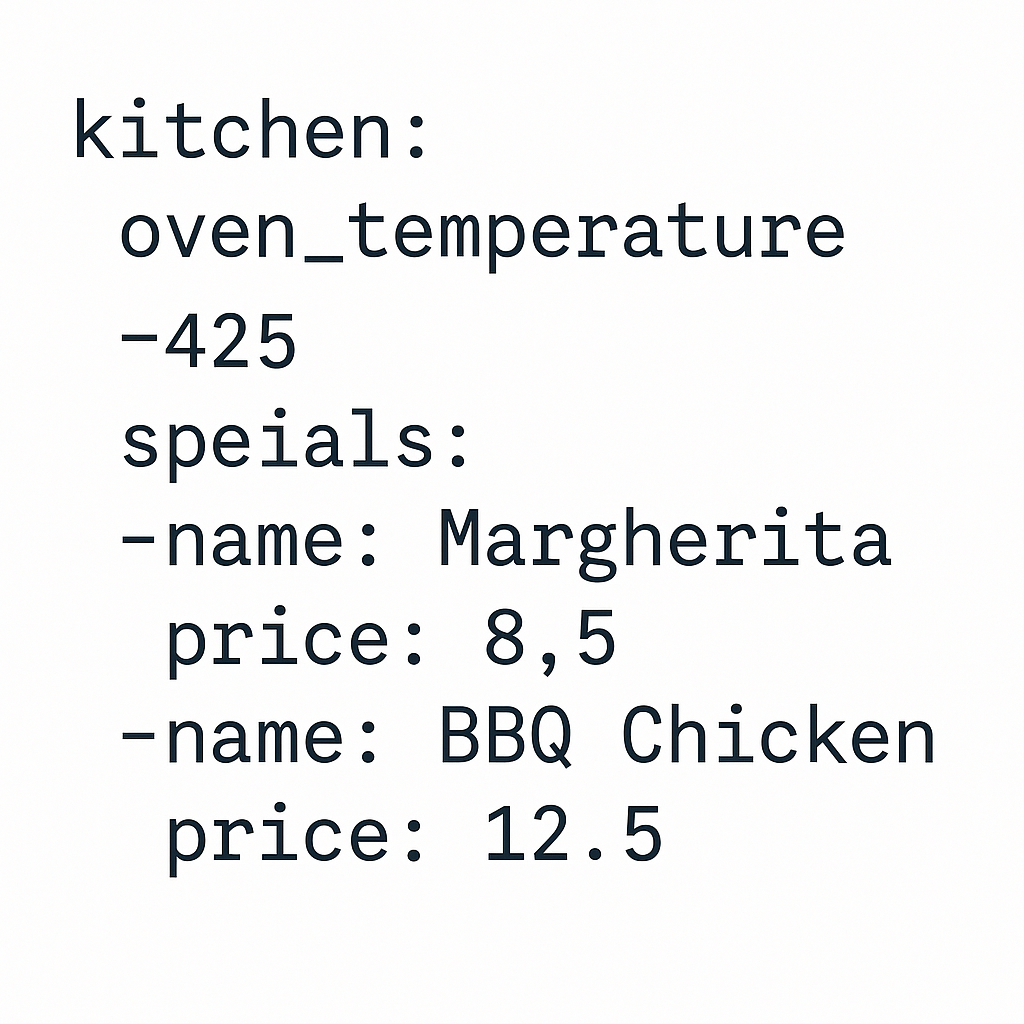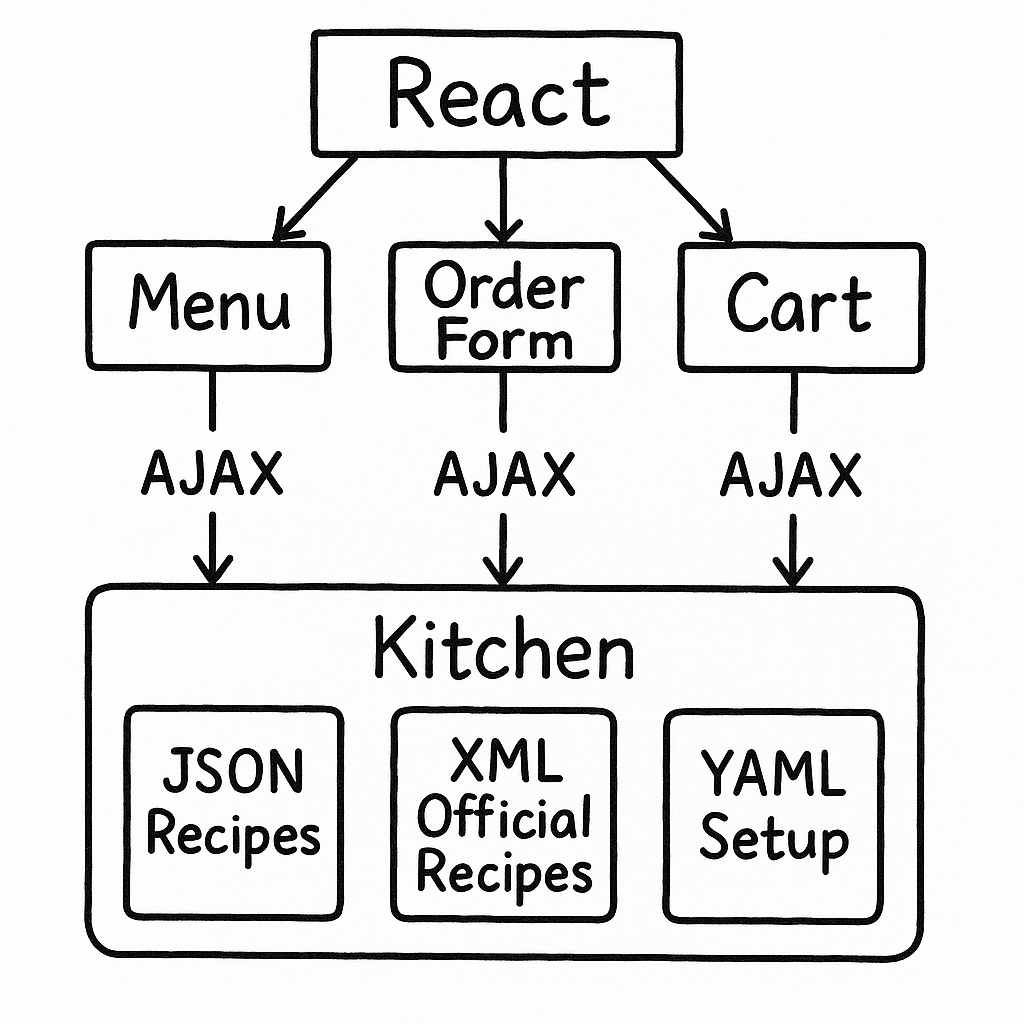Web Building Blocks: Understanding React, jQuery, AJAX, XML, JSON, and YAML
 Janhavi Vijay Chavada
Janhavi Vijay Chavada
React
React is like a set of LEGO blocks for building websites and apps. Imagine you want to build a website with buttons, pictures, and menus. With React, you make each part (like a button or a menu) as a separate block, called a component. You can use these blocks again and again, just like LEGO pieces.
Why do people use it? It helps make websites faster, easier to build, and easier to fix if something breaks.
- Where is it used? Most modern websites and apps, like Facebook or Instagram, use React to build their pages.
jQuery
jQuery is an older tool that helps you make websites do cool things, like animations or responding when you click a button. Before tools like React, jQuery was super popular because it made it much easier to work with web pages.
Why do people use it? It was easy to learn and made websites interactive.
Where is it used? Still found in many older websites, but not used much for new ones because newer tools (like React) are better.
AJAX
AJAX is like a messenger that lets your website talk to a server without reloading the whole page. For example, when you scroll through Instagram and see new posts pop up without the page reloading, that’s AJAX at work.
Why do people use it? It makes websites feel faster and smoother.
Where is it used? Everywhere you see new content appear without refreshing the page.
XML
XML is a way to organize and store information using special tags (like <name> or <score>). It’s kind of like a very strict way of writing down data, so computers can read and share it. It looks a bit like HTML, but it’s just for data.
Why do people use it? It’s good for sharing complicated information, especially in big companies or between different computer systems.
Where is it used? Mostly in older systems, banks, or government data.
JSON
JSON (pronounced "jay-sawn") is a simpler, easier-to-read way to store and share information between computers. It looks like a list or a dictionary you might use in math or coding class.
Why do people use it? It’s easy for both people and computers to read, and it works really well with websites and apps.
Where is it used? Almost everywhere! Most modern apps and websites use JSON to send and receive data.
YAML
YAML is another way to write down information, but it’s even easier for people to read than JSON. It uses spaces and dashes, kind of like making a list.
Why do people use it? It’s super simple to read and write, so it’s great for settings and instructions for computers.
Where is it used? In tools that help run websites or apps, like when setting up robots to automatically test your code or launch your website.
What’s Most Popular Today?
React is the most popular for building new websites and apps.
JSON is the most popular for sharing information between computers.
YAML is very popular for writing instructions for computers (like setting up websites or apps).
jQuery and XML are mostly used in older systems.
AJAX is still used everywhere, but usually hidden inside tools like React.
If you imagine building a website like building a LEGO city:
React is your box of LEGO blocks for the buildings.
jQuery is like an old set of tools for fixing things.
AJAX is the delivery truck bringing new pieces without rebuilding the city.
XML and JSON are two different ways to write down what’s in your city.
YAML is like a simple checklist for setting up your city.
Overview of React, jQuery, AJAX, XML, JSON, and YAML in 2025
This comparison covers the current (2025) usage trends, primary use cases, and the latest tools for six key technologies: React, jQuery, AJAX, XML, JSON, and YAML.
Usage Trends in 2025
| Technology | Major Usage (2025) | Typical Use Cases | Latest Tools/Trends |
| React | Dominant for modern web and mobile apps | SPAs, dashboards, cross-platform apps | React 19, improved SSR, React Server Components, Suspense, WebAssembly integration, enhanced DevTools |
| jQuery | Declining, but still used for legacy and simple projects | Legacy sites, quick prototypes, cross-browser support | Large plugin ecosystem, maintained for compatibility |
| AJAX | Integral but abstracted by frameworks | Asynchronous data fetching in web apps | Built into frameworks (React hooks, Angular services), fetch API, integration with REST/GraphQL |
| XML | Niche, mainly in enterprise, standards, and legacy | Data interchange in finance, healthcare, complex documents | Automated XML mapping tools (e.g., Flexter), ETL integration, XML-to-JSON conversion |
| JSON | Ubiquitous for data interchange | APIs, web/mobile data, config files | Native JS support, REST/GraphQL APIs, JSON Schema, used in AI/ML data pipelines |
| YAML | Growing, especially in DevOps and config | Config files, CI/CD, IaC, API specs | Used in Kubernetes, Ansible, GitHub Actions, OpenAPI specs, valued for readability |
Detailed Comparison and Current Uses
React
Major Trend: React remains the leading frontend library for building interactive, scalable web and mobile applications. Its component-based architecture, high performance (via Virtual DOM), and massive ecosystem make it the go-to for modern SPAs and enterprise platforms.
Latest Tools/Features: React 19 introduces built-in AI features, improved server-side rendering (SSR), React Server Components, and better developer tools. Integration with WebAssembly and advanced state/data management via Suspense and concurrent rendering are key trends.
Use Cases: Performance-heavy SPAs, cross-platform apps (via React Native), SEO-optimized sites (with Next.js).
jQuery
Major Trend: jQuery is much less popular for new projects but still relevant for legacy applications and quick prototypes due to its simplicity and broad browser compatibility.
Latest Tools/Features: Maintained for legacy support, with a vast plugin ecosystem for rapid prototyping and minor enhancements.
Use Cases: Legacy web projects, quick MVPs, sites requiring broad browser support.
AJAX
Major Trend: AJAX is foundational for asynchronous data fetching but is now mostly abstracted by frameworks like React and Angular. Direct use of AJAX (XMLHttpRequest) is rare; instead, modern apps use fetch API or built-in hooks/services.
Latest Tools/Features: React’s useEffect/useState hooks, Angular’s HTTP services, integration with REST and GraphQL APIs.
Use Cases: Real-time updates, dynamic content loading, seamless user experiences in SPAs.
XML
Major Trend: XML is now a niche choice, used primarily in industries where strict validation, metadata, or complex data structures are required (e.g., finance, healthcare, enterprise data exchange).
Latest Tools/Features: Automated XML mapping (e.g., Flexter), integration with ETL/data warehousing, XML-to-JSON conversion, support in industry standards (XBRL, FHIR).
Use Cases: Industry data standards, complex document storage, legacy integration, data warehousing.
JSON
Major Trend: JSON is the default data interchange format for web APIs, mobile apps, and cloud services. Its lightweight, easy-to-read structure makes it ideal for modern development.
Latest Tools/Features: Native JavaScript support, JSON Schema for validation, extensive use in REST and GraphQL APIs, integration with AI/ML pipelines.
Use Cases: API data exchange, config files, web/mobile app data, cloud/serverless functions.
YAML
Major Trend: YAML is increasingly favored for configuration, especially in DevOps, CI/CD, and infrastructure as code (IaC) due to its readability and flexibility.
Latest Tools/Features: Used in Kubernetes, Docker Compose, Ansible, GitHub Actions, OpenAPI specs. YAML’s human-friendly syntax is driving its adoption for config and orchestration.
Use Cases: Configuration files, CI/CD pipelines, container orchestration, API specifications, infrastructure management.
Which Is Majorly Used Today?
React is the dominant choice for building modern, scalable web and mobile applications, with a strong ecosystem and continuous innovation.
JSON is the universal data exchange format for APIs and modern apps, due to its efficiency and native support.
YAML is rapidly rising for configuration and DevOps, especially with the growth of cloud-native and containerized environments.
AJAX remains essential but is now a behind-the-scenes mechanism, abstracted by frameworks.
jQuery and XML are primarily used for legacy support and in specialized domains, not for new mainstream projects.
Latest Tools and Ecosystem Highlights
React: React 19, Next.js 14, React DevTools, React Server Components, Suspense, WebAssembly integration.
jQuery: Maintained plugin ecosystem, used for legacy browser compatibility.
AJAX: fetch API, React/Angular hooks and services, integration with REST/GraphQL.
XML: Flexter (automated mapping), ETL tools, XML-to-JSON converters, industry-specific standards.
JSON: REST/GraphQL APIs, JSON Schema, support in AI/ML, serverless functions.
YAML: Used in Kubernetes, Ansible, Docker Compose, GitHub Actions, OpenAPI, CI/CD tools.
Conclusion
React, JSON, and YAML are the major technologies driving web and cloud development in 2025, with React leading for UI, JSON for data interchange, and YAML for configuration and DevOps. AJAX is foundational but abstracted by frameworks, while jQuery and XML persist mainly for legacy and specialized use cases. The choice depends on your project’s needs, but for new development, React (with Next.js), JSON, and YAML are the most future-ready and widely adopted options
🍕 Fun Example: The Pizza Restaurant
Imagine you have a pizza restaurant website where people can order pizzas online.
1. React
Think of React as the chef who builds your pizza—one topping at a time. Each part of the website (menu, order form, shopping cart) is like a different pizza topping that you can mix and match.
- Example: The menu, the order button, and the shopping cart are all React components (pizza toppings).
2. jQuery
jQuery is like an old kitchen tool that helps the chef do things faster, like flipping a pizza or opening the oven. It’s still around, but newer tools are often better.
- Example: If you want the menu to slide open with a cool animation, you might use jQuery (but most new pizza places use React for this now).
3. AJAX
AJAX is the waiter who runs between the kitchen (your website) and the storeroom (the server) to get new orders or check what ingredients are available—without making everyone in the restaurant get up and leave.
- Example: When you add a pizza to your cart, AJAX sends your order to the server and brings back a message: “Order received!”—all without reloading the page.
4. XML
XML is like a very formal recipe card. It has lots of rules and is very organized, but it can be hard to read if you’re in a hurry.
- Example: The head office sends all restaurants a big XML file with the official pizza recipes.
5. JSON
JSON is a quick, easy-to-read recipe note. It’s simple and everyone in the kitchen can understand it right away.
Example: When the website wants to know what pizzas are available, the server sends back a list in JSON format:
{ "pizzas": [ { "name": "Margherita", "price": 8 }, { "name": "Pepperoni", "price": 10 } ] }

6. YAML
YAML is like a sticky note on the fridge with the day’s specials or kitchen instructions—super easy to read.
- Example: The kitchen setup is written in YAML:
oven_temperature: 220C specials:
Veggie Delight
BBQ Chicken

🖍️ Simple Drawing Idea
You can draw this on paper or imagine it:

React builds the parts you see (menu, order form, cart).
AJAX is the arrows sending and getting info without reloading.
JSON and XML are different ways the kitchen stores recipes.
YAML is the kitchen’s easy-to-read instructions.
Summary
React = Pizza chef (builds the website)
jQuery = Old kitchen tool (helps with tricks)
AJAX = Waiter (gets/sends data without leaving the page)
XML = Formal recipe card (old, detailed)
JSON = Quick recipe note (modern, easy)
YAML = Sticky note (super simple instructions)
Subscribe to my newsletter
Read articles from Janhavi Vijay Chavada directly inside your inbox. Subscribe to the newsletter, and don't miss out.
Written by
